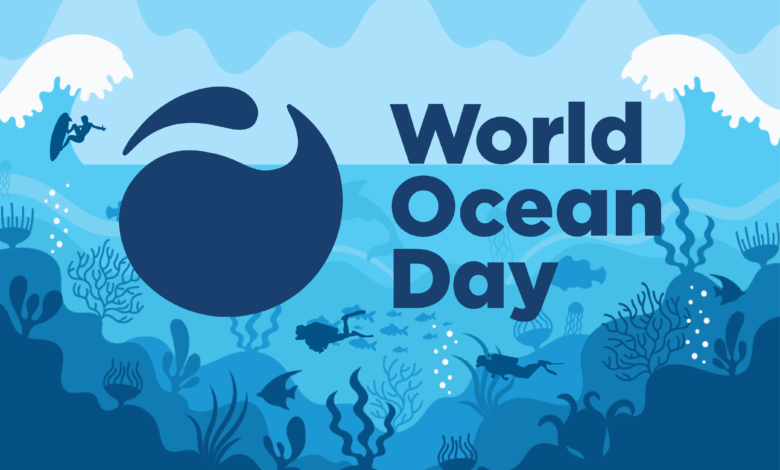World Ocean Day 2025: Protecting the Wonder That Sustains Us

Every year on June 8, we commemorate World Ocean Day, a global reminder of the essential role oceans play in our daily lives. Covering over 70% of Earth’s surface, oceans not only generate most of the oxygen we breathe but also regulate our climate, support an extraordinary variety of marine life, and provide resources vital to global economies.
However, growing threats such as pollution, overfishing, and climate change continue to endanger this lifeline of our planet.
World Ocean Day 2025 urges everyone to raise awareness and take meaningful action to preserve the health of our oceans. This year’s theme, “Wonder: Sustaining What Sustains Us,” encourages us to reflect on our connection with the ocean and the importance of maintaining its beauty and biodiversity for generations to come.
The Need to Protect the Ocean
The ocean is one interconnected, vast body of water, often divided into regions like the Pacific, Atlantic, Indian, Arctic, and Southern Oceans. But beyond its geography, it plays a vital role in supporting life on Earth. It works in harmony with other water bodies—seas, gulfs, bays, lagoons, estuaries, and even groundwater systems to sustain ecosystems.
Oceans provide numerous life-sustaining services. In addition to producing much of the oxygen we need, they are home to an incredible range of species, support livelihoods for millions, and act as a major climate buffer.
This World Ocean Day calls for a serious rethink of our often exploitative relationship with the ocean. As we mark this occasion, it’s time for a reset and an opportunity to educate everyone about ocean conservation and to engage younger generations as future stewards of the seas.
Why Are Oceans Under Threat?
The oceans are under unprecedented pressure. Research published in 2023 revealed that 2024 was the warmest year on record, with sea temperatures rising more than at any point in human history. This warming is linked to global climate change, driven by human activities like burning fossil fuels and industrial emissions.
These greenhouse gases trap excess heat from the sun, raising Earth’s average temperature, and oceans absorb much of this heat. The result? Coral bleaching, migration of marine species, and collapse of fragile ecosystems. Many ocean animals and plants are struggling to survive in these rapidly changing conditions.
That is why it is necessary to educate all and sundry on protecting the ocean. Children learning about these realities will motivate them to become protectors of the oceans by imbibing healthy habits that protect the ocean life.
A Brief History of World Ocean Day
The idea of World Ocean Day was first proposed at the 1992 Earth Summit in Rio de Janeiro by two Canadian organizations: the Ocean Institute of Canada and the International Centre for Ocean Development. The aim was to spotlight the crucial role oceans play in sustaining life.
However, it wasn’t until 2008 that the United Nations officially recognized June 8 as World Oceans Day. Since then, it has become a platform for nations, organizations, schools, and communities to come together and promote ocean conservation.
Educational outreach, especially targeting schools and youth organizations, has become a central element of these celebrations, helping to build a culture of environmental responsibility from an early age.
Why World Ocean Day Matters
1. Perspective
For many, the ocean is a place for fun and relaxation. But beneath the surface lies a delicate web of life, home to over one million species. Understanding the ocean’s true value helps us realize that protecting it is essential not just for our enjoyment but for the planet’s survival. Teaching children to see beyond the waves fosters a deeper appreciation of nature.
2. Motivation
Oceans cannot clean up after us. Much of our waste, especially plastic, ends up in the water and stays there. Children and adults alike can learn simple habits, like using the right recycling bins or reducing single-use plastics, that make a big difference over time.
3. Majesty
Whether it’s the roar of waves or a calm sea at sunset, its beauty is unmatched. Helping children connect emotionally with the ocean, through stories, visits to aquariums or beaches, and art, can instill respect and love that leads to long-term care.
Ways to Observe World Ocean Day
1. Organize or Join a Beach Cleanup
One of the most impactful ways to celebrate World Ocean Day is to participate in a beach cleanup. Whether with family, classmates, or local organizations, cleaning up even a small area makes a big difference.
Encourage sustainable habits like using reusable bags, water bottles, and utensils. A clean beach shows respect for both nature and community.
2. Make a Pledge
The Ocean Project website offers great ideas for how to celebrate. Families, schools, and individuals can make pledges to reduce plastic use, support marine conservation programs, or spread awareness.
This can also be a fun classroom activity: let children write their ocean pledges and share them on bulletin boards or social media with hashtags like #WorldOceanDay or #ProtectOurOceans.
3. Take the “We Are Blue, Tell Two” Challenge
People wear blue to show support on this day. But don’t stop there, share facts about the ocean with someone else. Teachers can also use this as a quick classroom exercise. Children can draw pictures of their favorite ocean animals and include fun facts to share with friends and family.
Conclusion
On World Ocean Day, we are reminded that the future of our planet is closely tied to the health of our oceans. Whether we live by the coast or in a landlocked city, we are all connected by the same waters.
The ocean’s protection is not just an environmental issue, it’s a matter of human survival and health. From efforts like beach cleanups to policies and youth education, every action counts.
Let’s commit today to being custodians of the blue because by sustaining what sustains us, we ensure a thriving, beautiful planet for generations to come.





